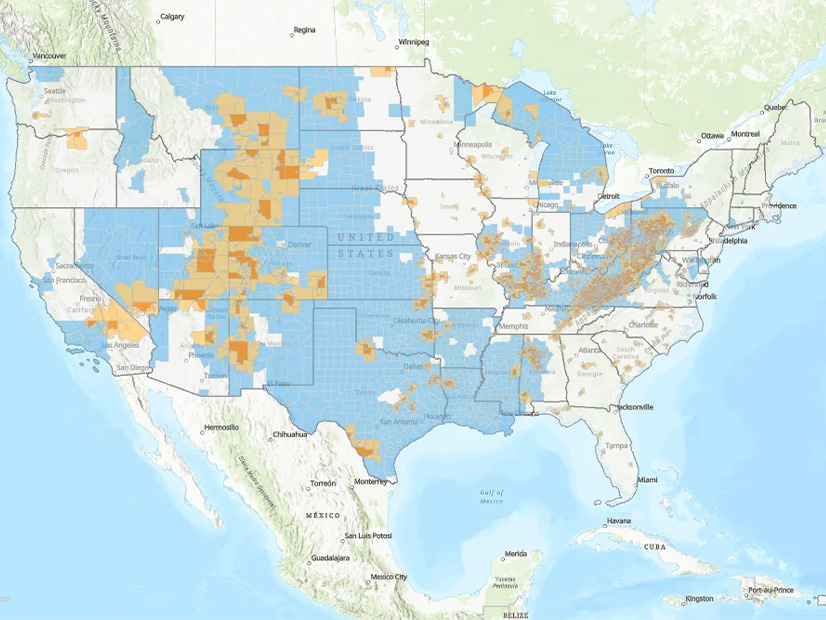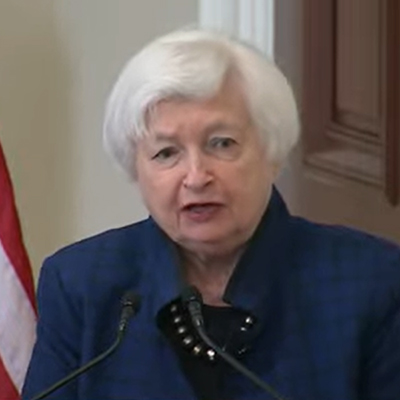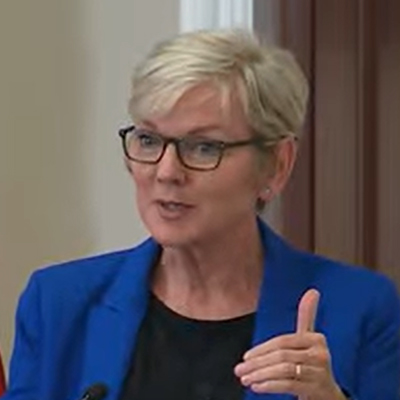
Millions in new funding and bonus tax credits are heading to new clean energy projects in U.S. “energy communities” — the cities, towns and counties where the closure of coal mines, coal-fired power plants and other fossil fuel projects has meant lost jobs and tax revenue, according to Tuesday’s round of White House announcements,
Rolled out at the meeting of the Interagency Working Group on Coal and Power Plant Communities and Economic Revitalization (Energy Communities IWG), the announcements included:
- new guidance from the Treasury Department on the Inflation Reduction Act’s 10% bonus credit for clean energy projects located in energy communities. A new map from Treasury and the IWG shows wide swaths of the country qualifying as energy communities, from Nevada to the Dakotas to Texas and the Mid-Atlantic coal belt in Pennsylvania, Ohio and Virginia;
- $16 million in funding from the Infrastructure Investment and Jobs Act for demonstration projects in North Dakota and West Virginia that “will extract and separate rare earth elements and other critical minerals from coal ash, acid mine drainage and other mine waste,” according to a White House fact sheet;
- another $450 million from the IIJA for additional clean energy demonstration projects on current and former mine lands. DOE estimates the U.S. has 17,750 mine land sites, covering 1.5 million acres, which could produce up to 90 GW of clean energy; and
- an interagency memorandum of understanding that will set up rapid response teams to provide outreach and technical support to energy communities to ensure they can access funding and other opportunities.
The announcements are part of President Biden’s bigger drive to highlight the successes of his “Investing in America” agenda and the programs and projects funded by the IIJA and IRA. The IWG has “driven more than $14.1 billion in federal investments to energy communities” over the past two years, according to a report also issued Tuesday.
 National Climate Adviser Ali Zaidi | Energy Communities IWG
National Climate Adviser Ali Zaidi | Energy Communities IWG
“There’s enormous untapped potential in these communities, from fossil fuel workers whose skills we need to build the industries of the future, to existing facilities that can be retooled and repurposed, to local entrepreneurs and universities … working to attract talent and investment,” White House Senior Adviser John Podesta said at the IWG meeting.
National Climate Adviser Ali Zaidi stressed the importance of creating new jobs that will let residents stay in their coalmining communities. “It’s not just … we say, ‘Hey, we’ve got a job for you in a completely different geography,’” Zaidi said.
“It’s the places that folks have invested in, not just in this generation, but for many a culture, a community, a sense of place and purpose and dignity. That’s all embedded in geographies … places [that] will be the venue where we come up with the ideas that we forge together and implement together,” he said.
‘An Extra Dime’
The 10% bonus tax credit for energy communities could be a major draw for investment in energy communities, adding 10% on top of any other investment or production tax credits the IRA provides for clean energy projects, Treasury Secretary Janet Yellen said.
“Many energy communities have the knowledge, the infrastructure and the resources to take advantage of the clean energy transition, but in many cases these communities could benefit significantly from an initial public investment to jumpstart that process,” she said.
 Treasury Secretary Janet Yellen | Energy Communities IWG
Treasury Secretary Janet Yellen | Energy Communities IWG
The bonus credit “generally means that if you’re a solar farm operator in a coal community, you get an extra dime on the dollar for your investment in a new facility,” Yellen said, adding that developers will also have to pay prevailing wages and have registered apprenticeship programs to take full advantage of the bonus.
The IRA provides a 30% investment tax credit or a 2.75-cent/kWh production tax credit for renewable energy projects. The impact of adding the 10% bonus credit to those incentives “is just going to be incredible,” said Tom Cormons, executive director of Appalachian Voices, a community nonprofit in Virginia. It will provide the boost needed to bring on “scores of projects that otherwise would not have penciled out or gotten over the finish line in places where it can be a little harder than others to get clean energy projects going on the ground,” he said.
The IRA provides a particularly broad definition of energy communities, and the Treasury Department guidance spells out the various ways a community can quality. Any community where a coal mine has closed since 2000, or any county adjacent to that area is identified as an energy community, as are areas where a coal-fired power plant has closed since 2010. So are “brownfield” sites where construction of any new projects or repurposing of existing infrastructure “may be complicated by the presence or potential presence of a hazardous substance, pollutant or contaminant,” the guidelines say.
Communities can also qualify if they have a minimum of .17% employment or 25% of tax revenue directly related to fossil fuel production or use and an unemployment rate higher than the national average.
Echoing Cormons, Hy Martin, chief development officer for D.E. Shaw Renewable Investment, said the IRA’s clean energy tax credits, including the 10% bonus, have “catalyzed several hundred millions of dollars in investment that we have committed to communities, specifically coal communities across the country …
“Without that kind of clear policy signal, those commitments wouldn’t have been made by us and certainly by our peers in the private sector,” Martin said.
‘Irresistible for Investment’
 Energy Secretary Jennifer Granholm | Energy Communities IWG
Energy Secretary Jennifer Granholm | Energy Communities IWG
Energy Secretary Jennifer Granholm also talked up the impact of the IRA, saying the law’s tax credits and other incentives are making energy communities “irresistible for investment.”
But Granholm’s main announcements Tuesday came with funding from the IIJA, the $16 million for the North Dakota and West Virginia demonstration projects and the $450 million for clean energy projects on mine lands.
The $16 million will be evenly split between North Dakota and West Virginia and used for “front-end engineering and design studies to determine how to extract critical minerals from coal mine waste streams, of which there are an abundant amount across the country,” Granholm said.
“Those efforts are going to help us stand up a first-of-its-kind facility that produces essential materials for solar panels, for EVs, for wind turbines … while at the same time cleaning up polluted land and water,” she said.
Sen. Joe Manchin (D-W.Va.) also welcomed the funding, saying that by reclaiming water from mining waste, “we will ensure that we are producing these materials in the cleanest way possible while addressing environmental liabilities.”
The $450 million will target projects using a “range of technologies — geothermal, energy storage, power plants [with] carbon capture,” Granholm said. “They’re going to show us how we can reactivate or repurpose existing infrastructure, like transmission lines and substations, while creating new opportunities for economic development.”
Granholm stressed that applicants chosen for this funding will also have to submit community benefit plans to ensure that projects are “designed in a way that uplifts the whole community.” Community benefits will constitute 20% of the scoring for the awards.
“We don’t think these projects are going to be successful unless they have meaningful community and worker engagement,” she said.
Concept papers for the $450 million opportunity are due May 11, with full applications to follow on Aug. 31, according to DOE.

